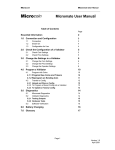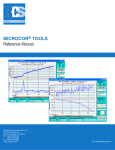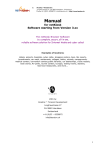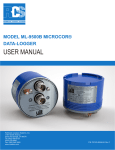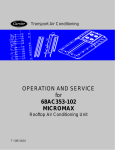Download MICROCOIN S5 OPERATING INSTRUCTIONS
Transcript
MICROCOIN S5 OPERATING INSTRUCTIONS These operating instructions will explain how you can use the Micromate programmer to customize your Microcoin validator, check existing programs, program new coins or tokens and generally understand the operation of the validator. TOPICS • Using the Micromate Hand-held Programmer • Checking the validator settings • Setting prices and coin values • Enabling and disabling particular coins • Programming new coins or tokens • Assigning coin output lines • Altering the validator pulse width • Clear all • Programming Guide • Quick Reference Guide • Glossary of Terms BACKGROUND The Microcoin S5 Validator is designed as a fully programmable coin validator that can be tailored quickly and efficiently to our own operating requirements. When the S5 is manufactured, it is pre-programmed with a standard configuration that contains the typical coin denominations used in your country and sets other parameters according to the application it is working into. The labels on the validator will give a visual indication of what these parameter settings are. (You may refer to the glossary for an explanation of the different parameters.) The S5 operates by detecting the presence of a coin that has been inserted and comparing it against a set of stored values within its memory. If the coin matches these values, the white “gate” inside the unit will open and allow the coin to pass into the “accept” path. Before exiting the validator, the coin passes two sets of sensors. These are used to detect any “stringing” attempts and to check that the coin has indeed left the validator. If the S5 sees a “stringing” attempt, it will immediately issue an alarm signal to your machine if a coin exits the unit, the S5 will issue a credit pulse. If the coin does not match the stored values, the gate does not move and the coin is directed into the “reject” path. You may use our Micromate programmer should you wish to customize the settings of the S5. The Micromate programmer is a portable unit specifically designed for this purpose. USING THE MICROMATE HAND-HELD PROGRAMMER About the Micromate The Micromate is an extremely useful tool that allows you the flexibility of setting up your validator to operate exactly how you wish. It has a keyboard, visual display, and a connecting ribbon cable. The Micromate operates in “modes”, each mode access a particular parameter. There are a total of eight modes available.You receive a visual indication of the mode you are in by way of the row of lights situated above the keypad. You select the desired mode by pushing the “M” button followed by the mode number. A beep will be heard and the corresponding mode number light will become illuminated. The “EN” key is used to enter changes you have made or to step through parameter settings. There is a reference table on the back of the Micromate to assist you. Connecting the Micromate The Microcoin validator has a ribbon cable attached to it that is connected to a small interface board. This interface board provides access to and from the host machine. In order to use the Micromate you must: 1. Carefully disconnect the validator connector from the interface board. Do not attempt to remove the ribbon cable from the validator as it is fixed inside the validator. 2. Insert the plug at the end of the Micromate cable into the interface board. 3. Take the validator connector and plug it into the socket located midway along the Micromate cable. Once this is complete, you can program the validator. CHECKING THE VALIDATOR SETTINGS - MODE 1 Under Mode 1, you may view the programmable settings of the unit. Mode 1 is also used to change the discrimination band for a particular coin. - Select Mode 1 Mode 1 light will be illuminated and the display will show 0. - Select the coin category (1 to 12) to be viewed by pushing the number buttons and then the “EN” (enter) button. You will not that the Mode 1 light will start flashing. Light 1 Coin Value The number displayed is the Coin Value assigned to that particular coin Press “EN” Light 2 Coin Output Line This indicates the Coin Output Line to which the credit impulses have been directed. Press “EN” Light 3 Credit Pulses This number indicates how many Credit Pulses will be output for this coin. Press “EN” Light 4 Coin Status This value indicates whether this particular coin is (0) INHIBITED or, (1) ENABLED Press “EN” Light 5 Discrimination Band This number tells you if the discrimination window is set to NORMAL (1) or NARROW (2) Press “EN” If you do not wish to change the discrimination band from the one displayed, press the “EN” key only and you will EXIT Mode 1. SETTING PRICES & COIN VALUES - MODE 2 & 5 The S5 validator is equipped with a number of features to allow you to set up the value of a credit pulse and coin and token values. Credit Output Line - Mode 2 The key to the S5 operation is the credit output line which signals a credit to the host machine every time the amount of money inserted adds up to the programmed value of the credit pulse. This facility is called a single price accumulator and the value of the credit pulse can be set through Mode 2. Once this programmed threshold is reached, an output pulse is generated. If the threshold is exceeded, you may choose to either Cancel (1) or, Carry Over (0) the excess credits. The price value can be set from 0 - 9999. To set the accumulated price: - Select Mode 2. The current accumulated price value is displayed. - If you do not wish to change this value, push the “EN” key. - If you wish to change the value, enter the new value and then push the “EN” key. - The display should now show a “0” or “1”. This indicates the status for excess credits. To change, simply enter “1” to cancel excess credits or “0” to carry over excess credits and press “EN”. The value will be changed and the Micromate will automatically exit the mode. Coin Values - Mode 5 When the S5 validator is programmed to accept coins or tokens, these must be assigned a numerical value (typically their face value) to enable the price accumulator to work. As a coin is validated, its value is added to the accumulator and a credit pulse is issued when the accumulator credit threshold is reached. Note: Coins assigned a value of 0 will be accepted with no credit assignment. The value of each coin category (1-12) can be assigned as follows: - Select Mode 5. Mode 5 light will be illuminated and the display will show 0. - Enter the coin category required and press the “EN” key. - The current value for that particular coin will be displayed. - If no change is required, press the “EN” key. - If the value is to be changed, enter the new value and press the “EN” key. The Micromate will make the change, then automatically exit the mode. Ass you can see, the numerical value that is assigned to the coins, determines how the price accumulator works. For example, if you had a coin valued at 100 units and the price accumulator was set at 50, this coin would cause two credit outputs. If you had a coin valued at 10 units, and the price accumulator was set at 50, you need to insert 5 coins to obtain one credit pulse. ENABLING AND DISABLING PARTICULAR COINS - MODE 3 This mode is used to se the validator to either reject or accept a particular coin. The coins are programmed in coin categories (1 to 12), and if you wish to enable or disable a coin, we actually turn on or off the category the coin is programmed in rather than the actual coin. - Select Mode 3. Mode 3 light will illuminate and the display will show (0) - Select the coin category (1 to 12) by pressing the appropriate number buttons. Press the “EN” button. - If “1” is displayed, this coin category is enabled. For example, it will accept valid coins. If “0” is displayed, the coin category is disabled and it will reject these coins. - If you do not wish to change the setting, enter either “1” or “0” and press the “EN” key. - The Micromate will make the change and automatically exit the mode. PROGRAMMING NEW COINS OR TOKENS - MODE 6 With the Micromate, you may program the validator for up to 12 different coins or tokens. All you need is 10 representative coins from the denomination you wish to program. There are a number of steps to take before you can program the coin.You need to choose a spare coin category (if you are not re-programming a particular coin) then assign a value to the coin (Mode 5) and enable the coin (Mode 3). Now you may proceed: - Select Mode 6. Mode 6 light will illuminate and the display will show “0”. - Enter the required coin category (1 to 12) and press the “EN” key. The current coin value will be displayed if it has already been set in Mode 5. - Feed 10 sample coins through the validator. The coins should be representative of the coins or tokens used in normal circulation. Any existing settings for the number selected will be written over and lost. - Enter the required discrimination band. - If normal discrimination band is required, enter “1” and press the “EN” key. - If narrow discrimination band id required, select “2” and then press the “EN” key. It is recommended that if narrow band is selected, the validator should be programmed in situ (natural position or place). - If the coin category being programmed is in categories 1-6, the Micromate will automatically exit the mode and programming is complete.You can, if desired, check your new parameters in Mode 1. - If the coin category programmed is in categories 7-12, #4 mode light will be illuminated and the current output line number will be displayed. To understand this more, read about “Assigned Coin Output Lines, Mode 4.” - Enter the required output line number and press the “EN” key. If no change is required, just press the “EN” key. - The current number of pulses will now be displayed. Enter the number of pulses required and press the “EN” key. Maximum number for any one coin is 255. The Micromate will now automatically exit the mode. ASSIGNING COIN OUTPUT LINE - MODE 6 This mode is used to direct a credit pulse, or pulses of each of the 12 coins to a desired coin output (1-6). Remember that when you program a coin, the programming sequence will automatically designate that coin to an output line. This facility is used more for riled adjustments, should a validator need to be configured. The available functions are best understood with reference to the table below: COIN OUTPUT LINE NUMBER GROUP 1 COIN CATEGORIES GROUP 2 COIN CATEGORIES 1 2 3 4 5 6 1 2 3 4 5 6 X X X X X X 7 8 9 10 11 12 As there are only 6 physical coin output lines, there are two categories of coins that can be programmed. Group 1 Category: When coins are initially programmed in categories 1 to 6, their outputs are dedicated to a corresponding coin output line. For example, coin category 1 will give you a single credit pulse on coin output line #1, coin category 2 will give you a single credit pulse on output line #2 and so on for coins 3, 4, 5, and 6. This pre-set configuration may be altered under Mode 4 to re-direct the output of any Group 1 coin to any output line with any number of credit pulses. Group 2 Category: Unlike Group 1 coins, Group 2 coin category is not initially tied to any particular coin output line and can be programmed to be directed to any of the coin output line number (1-6) with any number of credit impulses. To set a particular coin’s output parameters, proceed as follows: - Select Mode 4. Mode 4 light will illuminate and the display will show “0”. - Enter coin category (1-12) to be programmed and press the “EN” key. - The current output line number will now be displayed. Enter the new output line number and press the “EN” key. If no change sis required, just press the “EN” key. - The current number of pulses will now be displayed. Enter the number of pulses required and press the “EN” key. The Micromate will make the change and then automatically exit the mode. ALTERING THE VALIDATOR PULSE WIDTH - MODE 7 The pulse width for the coin output line, alarm out put line, and the accumulated price line may be adjusted to between 5 and 9000 ms. Note that the pulse width setting is the same for all outputs. This feature is particularly useful when a host machine is unable to accept a fast stream of pulses and they need to be slowed down or perhaps when the validator is communicating with a high-speed device that can accept very fast pulses. - Select Mode 7. The current pulse width in ms will be displayed. (Default is 100 ms) - Enter the required pulse width and press the “EN” key. The Micromate will make the changes and automatically exit the mode. CLEAR ALL - MODE 8 To clear all programmable variables, proceed as follows: - Select Mode 8. - Enter 1111 and push the “EN” key. Any other entry will exit the mode. NOTE: MODE 8 WILL CLEAR ALL VALIDATOR SETTINGS. BE CAREFUL! PROGRAMMING GUIDE The following is offered as a Quick Reference Guide to programming the S5 Validator. Changes to Existing Functions - Check current coin parameters in Mode 1 - Make changes as required Programming Existing or New Coin - check current coin parameters in Mode 1 and determine existing or available coin numbers - set coin value in Mode 5 - program coin in Mode 6 - enable coin in Mode 3 Programming all Variables - set accumulated value in Mode 2 - enable coins in Mode 3 - set coin values in Mode 5 - program coins in Mode 6 - set pulse width in Mode 7 Note: Microsystems Controls would normally supply the S5 validator fully or partly programmed to your requirements together with the configuration details indicated. The above is offered as a guide only if changes are required or the validator has been supplied un-programmed for some reason. QUICK REFERENCE GUIDE Mode 1 VIEW COIN SETTINGS/SET DISCRIMINATION 1 2 3 4 5 6 enter coin number current coin value output line number number of credit impulses enabled (1), inhibited (0) set discrimination, normal (1), narrow (2) Mode 2 SET ACCUMULATED PRICE 1 set accumulated price (0-9999) 2 enabled (1), disable (0) Mode 3 COIN INHIBIT 1 enter coin category (1-12) 2 enabled (1), disable (0) Mode 4 SET COIN OUTPUT 1 enter coin category (1-12) 2 set output line number (1-6) 3 set number of output pulses (1-255) Light 1 2 3 4 5 Mode 5 SET COIN VALUE 1 enter coin category (1-12) 2 set coin value (0-9999) Mode 6 PROGRAM COIN 1 enter coin category (1-12) 2 feed in 10 sample coins 3 set discrimination, normal (1), narrow (2) 4 set output line number (1-6), Group 2 coins only 5 set number of output pulses (1-255), Group 2 coins only Mode 7 SET PULSE WIDTH 1 set desired pulse width (5-9000 ms) Mode 8 CLEAR ALL SETTINGS 2 enter clear settings code GLOSSARY OF TERMS PARAMETER DESCRIPTION S/Number the serial number that uniquely specifies your validator Config (CFG) alphanumeric code that names the configuration of the validator P/Number part number of the validator Date warranty reference data of the validator Audit indicates whether the optional audit facility is activated or not (Y/N) Security indicates whether the security option is activated or not (Y/N) Output Inhibit if inhibit signal is received, mech will cease outputting pulses (Y/N) Output Pulse output pulse width in milliseconds (ms) Accumulated Value value of price accumulator Accumulated Clear clear excess credits or retain (Y/N) Text Fields (1-12) 5 digit alphanumeric field for coin category identification (i.e. AUD$1) Enabled enable or disable programmed coin Discrimination wide or narrow discrimination bands (Y/N) - wide normal coin discrimination settings (for optimal coin acceptance) - narrow tight coin discrimination settings (to assist in slug/fraud rejection) Output Line indicates which output a programmed coin is directed to Number of Pulses number of pulses required to output on selected O/P line Coin Category numbered allocation of the 12 available coin or token positions Value value of programmed coin (i.e. $1 is 100)










